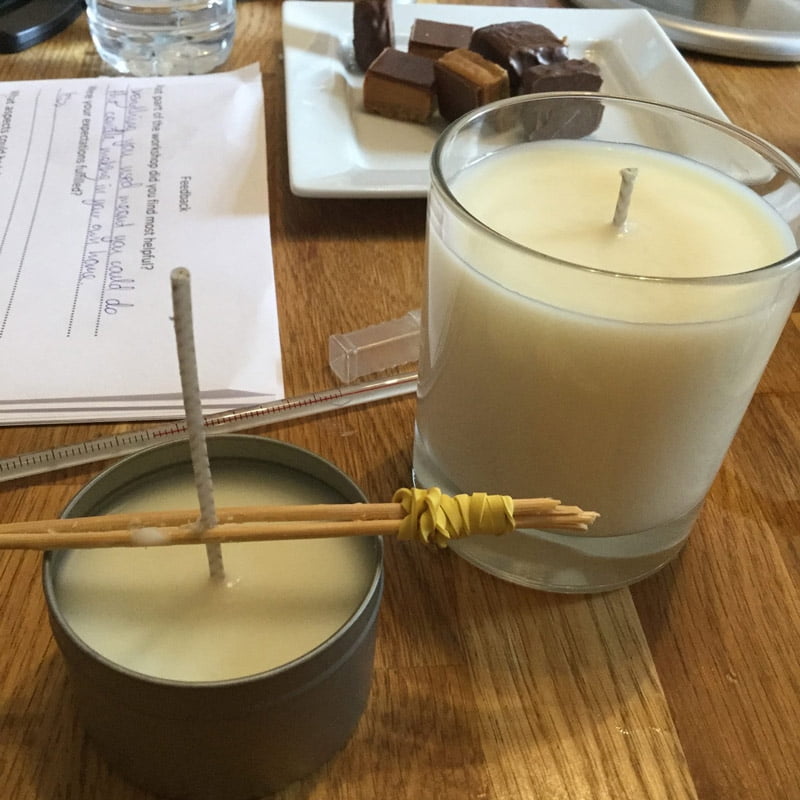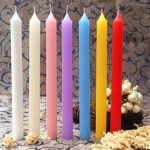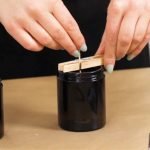Candle making is a delicate craft that requires careful attention to detail and precise temperature control. The temperature at which wax is melted, poured, and cooled plays a vital role in the final quality of the candle. To achieve consistent results and avoid common issues such as overheating or improper consistency, it is essential to use a thermometer specifically designed for candle making.
The use of a thermometer in candle making ensures that the wax is heated to the optimal temperature without causing burning or overheating. This is crucial because excessive heat can lead to discoloration, reduced fragrance throw, and even potential safety hazards. On the other hand, insufficient heat may result in poor adhesion between fragrance oils and wax, leading to weak scent projection. By monitoring temperatures closely, candle makers can strike the perfect balance for achieving high-quality candles.
There are various types of thermometers available for candle making, each with its advantages and disadvantages. Digital thermometers offer convenience and quick readings but may not be suitable for extreme temperatures. Traditional mercury thermometers are reliable but raise concerns about safety due to their toxic nature if broken.
Candy/fry thermometers are often favored by candle makers for their accuracy and versatility in monitoring wax temperatures. Additionally, glass-mercury thermometers provide an alternative choice while addressing environmental concerns associated with mercury content. Infrared thermometers offer a non-contact option that measures surface temperature accurately.
Benefits of Using a Thermometer in Candle Making
Using a thermometer is an essential tool in the process of candle making. It not only helps ensure the safety and quality of the final product, but also allows for greater control over various aspects of the candle-making process. By using a thermometer, candle makers can achieve optimal results in terms of melting, pouring, fragrance throw, and overall consistency.
One major benefit of using a thermometer in candle making is that it helps to prevent burning or overheating of the wax. Different waxes have different melting points, and heating them beyond these points can result in discoloration or even combustion. By monitoring the temperature with a thermometer, candle makers can ensure that they melt their wax at the appropriate temperature range.
Another advantage of using a thermometer is that it allows for precise control over the consistency of the melted wax. Candle makers need to pour and mold their candles at specific temperatures to achieve the desired results. If the wax is too hot, it may shrink or crack as it cools.
On the other hand, if it is too cold, it may not adhere properly to the container or have a poor fragrance throw. A thermometer enables candle makers to maintain consistent temperatures throughout the process and produce high-quality candles.
Additionally, using a thermometer enhances the fragrance throw and overall quality of candles. Certain fragrances have specific temperature ranges at which they are most effective. By accurately measuring and controlling the temperature while adding fragrances to the melted wax, candle makers can optimize their scent distribution and create candles with desirable aroma strength.
In summary, utilizing a thermometer in candle making provides several benefits for both safety and quality control purposes. It ensures proper melting without causing burning or overheating, facilitates achieving optimal consistency for pouring and molding candles, and enhances fragrance throw and overall quality of final products.
| Benefits | Description |
|---|---|
| Prevents burning and overheating | A thermometer helps to monitor the temperature to prevent wax from reaching dangerous levels, ensuring safety during the candle-making process. |
| Control over consistency | Candle makers can achieve the desired consistency by monitoring and maintaining proper temperatures throughout the melting, pouring, and molding stages. |
| Enhanced fragrance throw | The use of a thermometer allows for precise temperature control when adding fragrances, resulting in improved scent distribution in the final product. |
Types of Thermometers Suitable for Candle Making
When it comes to candle making, temperature control is crucial for achieving successful and high-quality results. To ensure that the wax is melted properly without causing burning or overheating, as well as achieving the perfect consistency for pouring and molding candles, using a thermometer is essential. There are several types of thermometers available that are suitable for candle making, each with its own advantages and disadvantages.
Digital Thermometers:
One type of thermometer commonly used in candle making is the digital thermometer. These thermometers offer precise temperature readings and are generally easy to use. They often have a digital display that gives an accurate reading, allowing candle makers to monitor the temperature of their wax closely. Digital thermometers also tend to be battery-operated, which makes them portable and convenient for use in different locations.
However, digital thermometers may not be as durable compared to other types of thermometers. The electronic components can be more sensitive to heat or accidental drops, which may decrease their lifespan. Additionally, some digital thermometers may require calibration or frequent battery replacements to maintain accuracy.
Traditional Mercury Thermometers:
Another option for candle makers is the traditional mercury thermometer. These classic thermometers have been used for years and are known for their reliability and consistency. Mercury thermometers offer accurate temperature readings and can withstand higher temperatures than digital alternatives.
However, it’s important to note that mercury thermometers come with safety concerns due to the toxicity of mercury. If mishandled or broken, they can release mercury vapors or liquid mercury that poses health risks. Due to these dangers, many countries have banned or restricted the use of mercury-containing products like these thermometers.
Considering environmental impact and safety concerns associated with traditional mercury-filled glass thermometers, it is advisable to explore alternatives such as mercury-free glass thermometers or other non-contact options like infrared (IR) thermometers.
Candy/Fry Thermometers for Candle Making
When it comes to candle making, using a thermometer is crucial for achieving the desired results. One type of thermometer that is commonly used in this craft is the candy/fry thermometer. Candy/fry thermometers are versatile tools that provide accurate temperature measurements, making them ideal for monitoring wax temperatures during the candle making process.
One of the key benefits of using a candy/fry thermometer in candle making is its accuracy. These thermometers are specifically designed to measure high temperatures accurately, which is essential when working with melted wax. By ensuring that the wax stays within the recommended temperature range, candle makers can avoid issues such as burning or overheating, which can affect the quality and performance of their candles.
In addition to accuracy, candy/fry thermometers also offer versatility. They can be used with various types of containers and molds, allowing candle makers to pour and mold candles with ease. Whether you’re working with small tealights or large pillar candles, a candy/fry thermometer can help you achieve the perfect consistency for your candles.
While using a candy/fry thermometer in candle making offers numerous advantages, it’s important to know how to use and care for it properly. To ensure accurate readings, it’s recommended to position the thermometer vertically in the wax without touching the sides or bottom of the container. After each use, clean the thermometer thoroughly with hot soapy water to remove any remnants of wax.
| Advantages | Disadvantages |
|---|---|
| Accurate temperature measurements | Requires direct contact with molten wax |
| Versatile for different types of candles | Can break if mishandled or dropped |
Glass-Mercury Thermometers for Candle Making
When it comes to selecting a thermometer for candle making, one popular option is the glass-mercury thermometer. These thermometers consist of a long glass tube filled with mercury, which expands or contracts based on temperature changes. While they have been widely used in various industries, including candle making, there are some concerns regarding their safety and environmental impact.
Safety Concerns and Environmental Impact:
One of the main concerns with glass-mercury thermometers is the potential health risks associated with mercury exposure. Mercury is a toxic substance that can be harmful if it comes into contact with the skin or is ingested. In addition, if a glass-mercury thermometer were to break during use, the release of mercury vapors can pose significant health risks to the candle maker and those in close proximity.
Furthermore, the improper disposal of mercury-filled thermometers can have detrimental effects on the environment. When thrown away in regular trash bins or dumped down drains, mercury from these thermometers can eventually find its way into water bodies and contaminate aquatic ecosystems. This contamination has far-reaching consequences for both humans and wildlife.
Alternatives to Glass-Mercury Thermometers:
Fortunately, there are alternatives available that eliminate the safety concerns and environmental impact associated with glass-mercury thermometers. One such alternative is using glass thermometers that do not contain mercury. These analog thermometers work similarly to glass-mercury ones but use an alcohol-based liquid instead of mercury.
Another popular option is digital thermometers, which use electronic sensors to measure temperature accurately. Digital thermometers are generally considered safe to use as they do not require any harmful substances like mercury. They also provide precise readings and often come with additional features such as automatic shutoffs and memory functions.
Infrared Thermometers for Candle Making
Infrared thermometers offer candle makers a non-contact alternative for monitoring the temperature of molten wax accurately. These thermometers work by measuring the surface temperature of objects without making direct contact, making them an ideal choice for candle making where precision is crucial.
One of the major advantages of using infrared thermometers in candle making is their ease of use. With a simple point and click, you can measure the temperature of your wax quickly and efficiently. This eliminates the need to wait for traditional thermometers to fully submerge in the wax or constantly check the temperature.
Additionally, infrared thermometers minimize the risk of contamination. In candle making, it’s important to maintain a clean and sterile environment to ensure high-quality candles. By not directly touching the wax with an infrared thermometer, you reduce the potential for introducing any foreign substances that could affect the final product.
It’s worth noting that not all infrared thermometers are suitable for candle making. When selecting an infrared thermometer, look for one specifically designed for measuring high temperatures. Candle wax can reach high melting points, so it’s essential to choose a thermometer that can accurately measure within that range.
To use an infrared thermometer for candle making, simply point it towards the surface of your molten wax and press the button to take a reading. Make sure to keep a safe distance to avoid injury from hot wax splatter or burns.
Overall, infrared thermometers offer convenience, accuracy, and minimal contamination risks when measuring temperatures in candle making. They are especially useful when working with large volumes of wax or needing quick temperature readings throughout various stages of the process.
Thermometer Selection Guide for Candle Makers
When it comes to candle making, temperature control is crucial for achieving the best results. That’s why selecting the right thermometer is essential for any candle maker. With so many options available, it can be overwhelming to choose the best thermometer for your specific needs. This section will serve as a thermometer selection guide to help candle makers make an informed decision.
One of the key factors to consider when choosing a thermometer for candle making is the recommended temperature range and accuracy. Different types of candles require different temperature ranges for melting and pouring the wax. It’s important to select a thermometer that can accurately measure within those specific temperature ranges. Additionally, ensure that the chosen thermometer has sufficient accuracy to provide precise measurements, as even slight variations in temperature can impact the quality of your candles.
Another aspect to consider when selecting a thermometer is its convenience and functionality features. Look for thermometers with clear and easy-to-read displays that allow you to monitor temperature changes accurately and quickly. Some thermometers also come with additional features such as timers or alarms, which can be helpful for tasks that require precise timing during candle making processes.
Lastly, durability and ease of maintenance are also factors worth considering. As you’ll be working with hot wax, it’s important to choose a thermometer made from high-quality materials that can withstand heat without getting damaged or affecting readings. Additionally, opt for thermometers that are easy to clean and maintain since they will regularly come into contact with various materials such as wax, fragrance oils, or dyes.
By carefully considering these factors such as recommended temperature range and accuracy, convenience features, durability, and ease of maintenance, you can confidently select a thermometer that suits your specific needs in candle making. Remember that choosing the right thermometer plays a significant role in achieving consistent quality candles every time you pour or mold them.
Tips for Proper Thermometer Usage in Candle Making
When it comes to candle making, using a thermometer correctly is crucial for achieving the best results. Here are some tips to ensure proper thermometer usage in this craft:
Choose the Right Thermometer
Before starting your candle-making process, make sure you have the appropriate thermometer. Consider factors such as temperature range and accuracy. Depending on your preferences and budget, you can choose between digital thermometers, traditional mercury thermometers, candy/fry thermometers, glass-mercury thermometers, or infrared thermometers.
Calibrate Your Thermometer
To ensure accurate temperature readings, it’s important to calibrate your thermometer before each use. Fill a container with ice water and insert the thermometer into it without touching the sides or bottom of the container. The thermometer should read 32°F (0°C). If not, make necessary adjustments accordingly.
Use Proper Insertion Techniques
When measuring wax temperatures, it’s essential to insert the thermometer properly to get accurate readings. For liquid waxes, dip the thermometer in about halfway without touching the container’s sides or bottom. If using a candy/fry thermometer or a glass-mercury thermometer with a clip, attach it securely to the side of the pouring pot or container.
Avoid Stirring with Thermometer
While it may be tempting to use your thermometer as a stirring tool during melting or mixing processes, this can lead to inaccurate readings or damage to the instrument. Instead, stir your wax using designated utensils like heat-resistant spatulas or spoons.
Maintain Cleanliness and Hygiene
Keep your thermometer clean by wiping it with alcohol wipes before and after each use. Avoid cross-contamination by using separate thermometers for different types of waxes or fragrance oils if necessary.
Handle with Care
Some thermometers, like mercury ones, can be fragile and contain hazardous materials. Always handle them with care to prevent breakage or exposure to harmful substances. If using glass-mercury thermometers, opt for safer alternatives like mercury-free glass thermometers.
Remember, using a thermometer correctly is not only essential for achieving the desired consistency and quality of your candles but also for ensuring your safety throughout the process. By following these tips, you can make the most out of your thermometer and enhance your candle-making experience.
Conclusion
The process of candle making is an art that relies heavily on temperature control. Using a thermometer is essential to ensure that the wax is melted at the right temperature, without burning or overheating. Throughout this article, we have explored the various types of thermometers available and their benefits in candle making.
One popular option is digital thermometers. While they offer quick and accurate readings, they can be more fragile and less durable compared to other types. On the other hand, traditional mercury thermometers have stood the test of time and are known for their reliability, but there are safety concerns due to the hazardous nature of mercury. Candy/fry thermometers are commonly used in candle making as well, with their accuracy and versatility being highly valued.
For those concerned about safety and environmental impact, mercury-free glass thermometers are a viable alternative to traditional mercury thermometers. Additionally, infrared thermometers offer a non-contact option for temperature measurement, minimizing contamination risks.
When selecting a thermometer for candle making, it is important to consider factors such as temperature range, accuracy, convenience features such as easy-to-read displays or alarm functions, and durability. It is also crucial to properly use and care for your thermometer to maintain its accuracy over time.
In conclusion, using a thermometer in candle making is crucial for achieving high-quality candles with precise temperature control. By making informed choices about the type of thermometer that best fits your needs and preferences, you can ensure successful outcomes in your candle making endeavors.
So go ahead and select the thermometer that suits you best – whether it’s a digital thermometer for easy reading or an infrared thermometer for non-contact measurements – and enjoy creating beautiful candles with precision and confidence.
Frequently Asked Questions
Do I need a thermometer for candle making?
A thermometer is a crucial tool to have when making candles. It helps you monitor and maintain the temperature of your wax, which is essential for achieving proper results.
Different types of wax have specific temperature requirements, so without a thermometer, it would be challenging to ensure that you are heating or cooling the wax to the correct degree. Additionally, using a thermometer ensures that you don’t exceed the recommended maximum temperature for your chosen wax, as overheating can lead to safety hazards or negatively impact the quality of your candle.
Can I use digital thermometer for candle making?
Yes, you can definitely use a digital thermometer for candle making. In fact, many candle makers prefer digital thermometers due to their ease of use and accuracy. Digital thermometers provide quick and precise temperature readings, allowing you to monitor the wax closely throughout the melting and pouring process.
They often come with features like memory recall or alarms that can be handy while working on multiple batches at once. Just make sure to choose a digital thermometer specifically designed for candle making or one with a wide temperature range that encompasses the melting point of your chosen wax.
Do you need a thermometer to make soy candles?
While it’s not mandatory to use a thermometer when making soy candles, it is highly recommended for optimal results. Soy wax has its own specific melting and pouring temperatures that differ from other types of wax. Using a thermometer allows you to closely monitor these temperatures and ensure that your soy wax melts completely but doesn’t overheat or burn, as this could affect fragrance throw or even cause fire risks.
The right temperature control also helps in achieving smooth tops and reducing potential issues like sinkholes or frosting in your final soy candles. Whether using a traditional or digital thermometer, having this tool at hand will greatly assist you in mastering the art of soy candle making effectively.

Welcome to my candle making blog! In this blog, I will be sharing my tips and tricks for making candles. I will also be sharing some of my favorite recipes.





